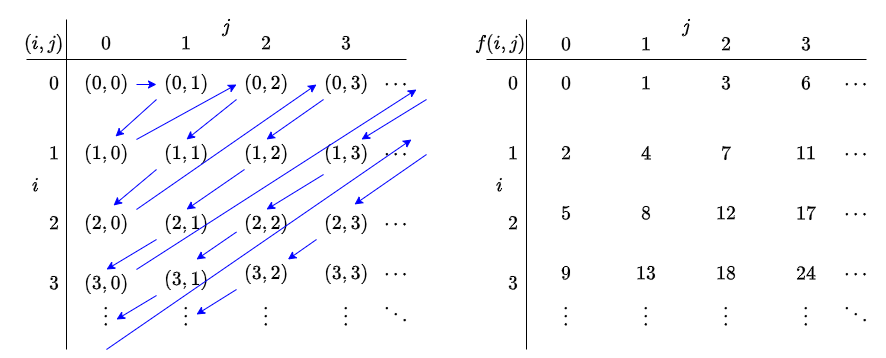Naive set theory: Size of a set
 Equipotency and (in)finiteness
Equipotency and (in)finiteness
We call the set \(X\) equipotent or equinumerous with respect to the set \(Y\), and we also say that \(X\) has the same cardinality or the same number of elements as \(Y\) if there exists a bijection \(f\:\;X\rightarrow Y\). We denote this as \(X\cong Y\). If two sets \(X\) and \(Y\) are not equipotent, we denote this with \(X\ncong Y\).
The relation "is equipotent to" is an equivalence relation between sets. This means that for arbitrary sets \(X\), \(Y\), and \(Z\):
- \(X\cong X\);
- If \(X\cong Y\), then \(Y\cong X\);
- If \(X\cong Y\) and \(Y\cong Z\), then \(X\cong Z\).
Examples
- \(\{a,b,c\}\cong \{1,2,3\}\)
because the function \(f\) defined by \(f(a)=1\), \(f(b)=2\), \(f(c)=3\) is a bijection from \(\{a,b,c\}\) to \(\{1,2,3\}\). - \(\{a,b,c,d\}\ncong \{1,2,3\}\)
because the pigeonhole principle guarantees that there is no injective function from \(\{a,b,c,d\}\) to \(\{1,2,3\}\), let alone a bijection. - The closed interval \([0,1]\) in \(\mathbb{R}\) is equipotent to any other closed interval \([a,b]\) (with \(a<b\))
because the function \(f\) defined by \(f(x)=(b-a)x+a\) is a bijection from \([0,1]\) to \([a,b]\). - The open interval \((-1,1)\) is equipotent to \(\mathbb{R}\)
because the function \(f:\;(-1,1)\rightarrow \mathbb{R},\quad f(x)=\tan(\tfrac{1}{2}\pi x)\) is a bijectie from \((-1,1)\) to \(\mathbb{R}\). - \(\mathbb{N}\backslash \{0\}\cong \mathbb{N}\)
because the function \(f\) defined by \(f(n)=n-1\) is a bijection from \(\mathbb{N}\backslash \{0\}\) to \(\mathbb{N}\). This means that when counting elements, it does not matter whether you start at \(1\) or \(0\). - \(\mathbb{Z}\cong \mathbb{N}\) because the function \(f(n)=\begin{cases}2n&\text{if }n\ge 0\\ -2n-1&\text{if }n< 0\end{cases}\) is a bijection from \(\mathbb{Z}\) to \(\mathbb{N}\).
A formal definition of finiteness and infiniteness of a set is as follows:
A set \(X\) is called
- finite if there exists an \(n\in \mathbb{N}\) such that \(X\cong\{0,\ldots , n-1\}\) (where \(\{\}=\emptyset\)).
The number of elements of \(X\), which we elegantly call the cardinality of \(X\), is then equal to \(n\) and we denote this as \(|X|=n\); - infinite if \(X\) is not finite.
Examples of infinite sets are the number sets \(\mathbb{N}\), \(\mathbb{Z}\), \(\mathbb{Q}\), and \(\mathbb{R}\)
\(\mathbb{N}\times \mathbb{N} \cong \mathbb{N}\)
Without proof:
\(\mathbb{R} \cong {\Large\wp}(\mathbb{N})\).
Unlock full access




